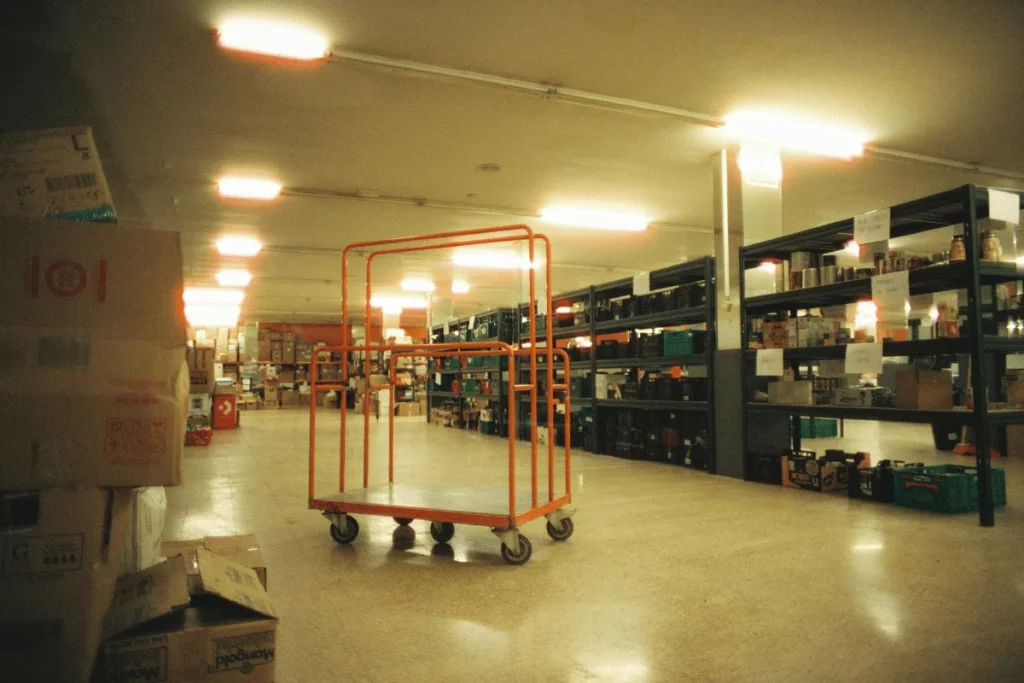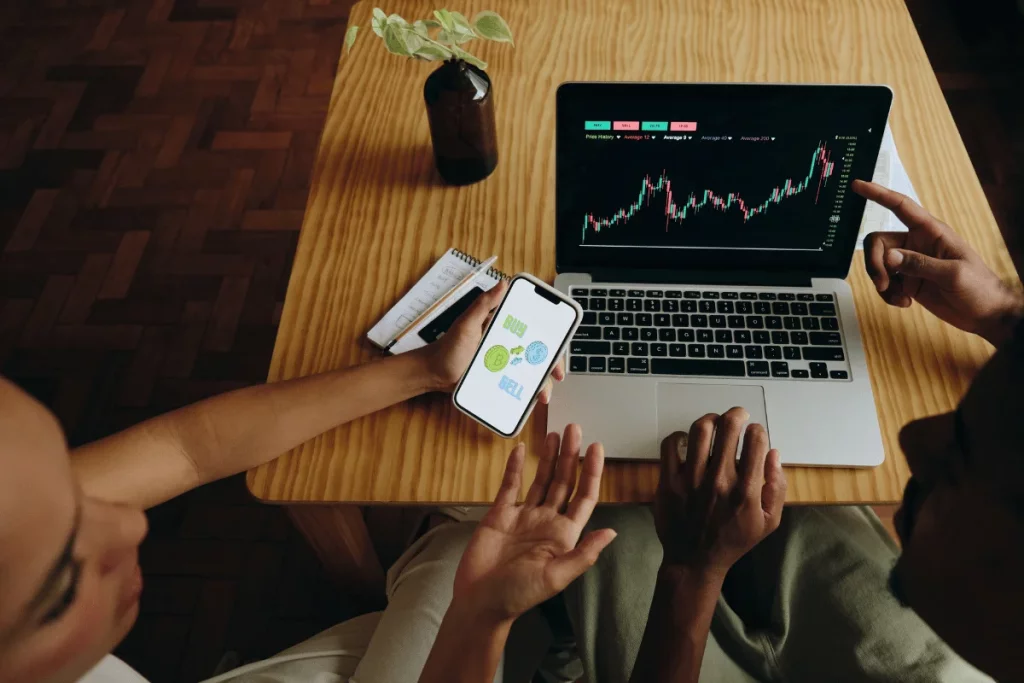Valuing a distribution business can be complex and challenging, as many factors affect its worth.
However, it is also an essential step for anyone who wants to buy, sell, or invest in one, as it helps to determine a fair and realistic price, negotiate better terms, and plan for future growth.
This blog takes a look at how we can do so. Let’s dive in!
These are the ten steps to be followed when valuing a distribution business.
Additionally, if you have the relevant data, you can use our valuation calculator for an easy overview and calculation of the value of your distribution business.

The valuation process is the systematic and logical way of estimating the value of a distribution business. It involves four main steps:
This involves collecting relevant data and information about the distribution business, such as its financial statements, client and supplier contracts, asset value, growth potential, industry comparables, etc.
Calculating the earnings of the distribution business is the most critical factor in determining its value. Different methods, such as SDE or EBITDA, can measure these earnings.
This step involves applying a multiple to the distribution business's earnings, which reflects the business's risk, growth, and profitability. The multiple can also be adjusted based on various factors and gives a precise estimation of the final sale price. For example, profitable distribution businesses are usually valued at 4-6x the EBIDTA or 2-4x the SDE.
The value of the distribution business is based on several factors that may affect its worth, such as working capital, inventory, debt, goodwill, intangible assets, contingent liabilities, and synergies. The final value needs to be adjusted based on these.

A distribution business's value is influenced by internal and external factors, affecting its risk, growth, and profitability.
Some of the most critical factors are:
The financial performance of the distribution business is measured by its revenue and earnings. It indicates its ability to generate income and profits and to sustain and grow its operations.
A company's market position is determined by its market share, customer base, competitive advantages, and brand recognition. It also indicates its ability to attract and retain customers and create a loyal and reputable brand.
The distribution business's asset value is calculated by the net worth of its tangible (inventory, equipment, etc.) and intangible (intellectual property, customer relationships, etc.) assets.
The growth potential can be estimated by opportunities and challenges, such as changing market size, demand trends, regulatory environment, and technological developments.
Values of similar distribution businesses sold previously in the market help set benchmarks.
It is determined by evaluating the ratio between the distribution business's output (revenue) and input (operational expense).
The geographic reach of a distribution business is measured by its regional coverage, penetration, and presence.
The specific and distinctive features, characteristics, and factors make the distribution business stand out, such as its history, reputation, goals, and objectives.

These are the most commonly used valuation methods for a distribution business.
It compares the distribution business to similar businesses or assets, using metrics such as price-to-earnings ratio. While the valuation method is simple and convenient, it may not capture the distribution business's unique characteristics or intrinsic value.
This method estimates the value of the distribution business based on its future cash flows or earnings, using techniques such as discounted cash flow analysis, EBITDA, or dividend discount models. It is comprehensive and forward-looking but requires many assumptions and projections, which may be uncertain or inaccurate.
This method calculates the value of the distribution business based on the net worth of its tangible and intangible assets, using techniques such as book value, market value, or income approach. It is objective and realistic but may not reflect the distribution business's growth potential or operational efficiency.
It applies the valuation methods commonly used or accepted in the distribution business, such as the income multiplier method, earnings-based valuation, or distributor method. This method is relevant and consistent but may not account for the differences or dynamics within the industry or the market.
Using these valuation methods, you can determine a distribution business's fair and realistic value and make strategic decisions. Plus, if you own a distribution business, you can use these methods for analysis and improving the value of your business.

Distribution multiples and metrics are used to measure and compare the value and performance of distribution businesses. These help prospects evaluate distribution businesses' profitability, liquidity, and activity to determine their fair and realistic data-backed prices.
One of the most common ways to value a distribution business is to use a multiple of its earnings, such as the seller's discretionary earnings (SDE) or earnings before interest, taxes, depreciation, and amortization (EBITDA).
The top distribution multiples and metrics are:
It reflects the operating performance and profitability of the business, as well as its potential growth and risk.
SDE measures the earnings of a small to medium-sized distribution business.
It reflects the efficiency of inventory management and the product demand.
It simply means how often a distribution business collects its outstanding accounts receivable in a given period.

Seller's discretionary earnings (SDE) measure the earnings of a small to medium-sized distribution business that considers the owner's salary, benefits, and other discretionary expenses. It represents the true earning potential of the business for a new owner/operator, and it allows a buyer to compare the business with similar businesses.
SDE is calculated by adding back certain expenses tied to the current owner, such as the owner's salary, benefits, interest, depreciation, and any one-time or non-recurring expenses. SDE is also adjusted for extraordinary, non-operating, or non-recurring income or costs, such as lawsuit settlements, natural calamity damages, or asset sales.
EBITDA multiple is a valuation metric used for valuing distribution businesses, especially larger ones (more than $5 million in annual revenue). EBITDA multiple is a ratio that compares the business's enterprise value to its earnings before interest, taxes, depreciation, and amortization (EBITDA). It reflects the operating performance and profitability of the business, as well as its potential growth and risk.
EBITDA multiple is calculated by dividing the business's enterprise value by its EBITDA. The enterprise value represents the total value of the business, including its market capitalization, debt, and other factors that affect its worth.
Meanwhile, the EBITDA represents the business's earnings before deducting interest, taxes, depreciation, and amortization, which are non-cash or non-operating expenses. EBITDA is usually based on the business's historical financial statements but can also be projected based on the expected future performance.

As with other businesses, distribution business valuations do not start with the actual financial assessments and actual calculations.
The preparational steps below apply:
At Exitwise, we can help you find, recruit, and work with the best M&A professionals in the industry to optimize your exit. Chat with our team today to learn more.

Valuing a distribution business is complex and challenging, as many factors affect its worth. Here are the steps/aspects to follow in a comprehensive valuation.
The first step in valuing a distribution business is to analyze its financial statements, such as the income statement, the balance sheet, and the cash flow statement. These statements provide information about the business's revenue, expenses, assets, liabilities, and cash flow and help measure its financial performance, health, and efficiency.
Is Distributorship Profitable?
Yes, distributorship is profitable if you can develop a good network with your client/supplier and choose the right products to distribute.
and Supplier ContractsThe second step in valuing a distribution business is to review its client and supplier contracts. These contracts provide information about the terms and conditions of the business relationships, such as the pricing, payment, delivery, quality, and exclusivity of the products and services. The contracts help measure the business's stability and profitability and affect its value and risk.
The third step is to evaluate its market position. The market position of the distribution business is determined by its market share, customer base, product portfolio, competitive advantages, and brand recognition. This indicates its ability to attract and retain customers, differentiate itself from competitors, and create a loyal and reputable brand. In summary, your market position of the distribution business deeply affects its value and growth.
The distribution business's asset value is calculated by the net worth of its tangible and intangible assets. These assets represent the business's resources and capabilities and significantly affect its value.

The growth potential is determined by the company's ability to increase its revenue, market share, customer base, and profitability over time. It measures the success and viability of the distribution business and is vital to its value and attractiveness to potential buyers.
Reviewing its industry comparables is an essential and fruitful step in valuing a distribution business. Look for data on companies operating in the same or related industry as the distribution business, with comparable size, growth, profitability, and risk profiles.
Industry comparables help to benchmark and evaluate the current and projected value of the distribution business by giving an idea of the market. It can also help a seller draft a more lucrative offer for potential buyers with previous/recent M&As as a reference.
Earnings multiples are valuation metrics that compare the distribution business's current or projected earnings to its market or enterprise value. They provide a realistic measure of a company's value based on factual data and reliable calculations. A good M&A advisor can help select the right earning multiple for calculating the most appropriate valuation of a distribution business.
Operational efficiency measures a business's efficiency through a ratio of operating costs and revenue. It can be improved by reducing waste, optimizing processes, increasing productivity, and enhancing quality. External factors, such as market conditions, customer demand, supplier reliability, and regulatory compliance, can also influence operational efficiency.
Geographic reach is how the distribution business can serve customers in different locations, regions, or markets. It can create opportunities and challenges affecting the business's value and growth.
The final step in valuing a distribution business is to account for its unique business attributes or what is usually called a USP (Unique Selling Proposition). The features or qualities make the distribution business stand out from its competitors and give it a competitive advantage.
Unique business attributes can enhance the value and attractiveness of the distribution business, as they can create a loyal and reputable brand and increase customer satisfaction and retention.

Since the valuation process of a distribution business is intensive, you'll want to ace it the first time you try.
Here are common business valuation mistakes to avoid:

Now that you know the mistakes to avoid, let's look at what you can do to optimize the value of your business:

An M&A advisor team is a group of professionals who work together to guide and support prospects who want to sell or buy a distribution business.
An M&A advisor team typically consists of the following:
The advisor is the primary intermediary who acts as the business owner's representative and coordinates the entire M&A process. The advisor also works closely with other team members to ensure a smooth and successful transaction.
The legal expert who advises the business owner on the legal aspects of the M&A deal, such as drafting and reviewing contracts, ensuring compliance with laws and regulations, and resolving any legal disputes or issues that may arise during the process.
A financial expert who assists the business owner with the financial aspects of the M&A deal, such as preparing and analyzing financial information and reports and providing tax advice and planning.
The financial intermediary who helps to raise capital for the M&A deal. The banker also acts as a liaison between the business owner and the lenders or investors, ensuring the funds' availability and adequacy.

Working with an M&A advisor team has outstanding benefits, some of which are listed below. Additionally, you may want to look at our customer success stories for reference:
An M&A advisor team can provide the business owner with the knowledge and skills necessary for a successful M&A deal. They are well-versed in all M&A terms and legalities, making the process a breeze.
The team can handle the complex and time-consuming tasks and processes in an M&A deal.
The team can help the business owner achieve the best possible outcome from the M&A deal, such as maximizing the price and ensuring the buyer's or seller's compatibility and synergy.

Although it's largely helpful, these are a few challenges of working with an M&A advisor team:
An M&A advisor team charges a fee for their services, which can be a percentage of the deal value, a fixed amount, or a combination of both. The fee depends on the size, complexity, and type of the deal.
An M&A advisor team may have different interests, goals, and incentives than the business owner, which can create conflicts or misunderstandings.
setlsd8zmijimageblog/challenges-of-working-with-an-m&a-advisor-team.png

Find answers to some common questions about how to value a distribution business.
Operational efficiency is a crucial aspect of valuing a distribution business, as it measures the efficiency of profit earned against the operating costs. The greater the operational efficiency, the more profitable and valuable a distribution business is. Since the company can generate more significant income or returns for the same or lower cost than an alternative.
Geographic reach is the extent to which the distribution business can serve customers in different locations, regions, or markets. A more extensive geographic reach means a distribution business has access to a bigger market and, hence, a better chance of sustaining current revenue numbers and expansion in the future.
Client relationships are the connections the distribution business has with its customers, such as through contracts, orders, service, support, referrals, and loyalty. Good client relationships can increase the valuation of the distribution business, as they represent a loyal customer base and the stability of the business.
Valuing a distribution business is a complex task involving many factors and methods that must be considered and applied. However, following the steps and techniques discussed in this blog, you can perform a comprehensive and accurate distribution business valuation to set the right deal.
If you want assistance with the valuation of your distribution business or finalizing an M&A deal, we at Exitwise will help you gather a team of seasoned M&A experts with comprehensive experience to get the most out of the transaction. Connect with us via email or set up a call here for a quick consultation.
Let Exitwise introduce, hire and manage the best, industry specialized, investment bankers, M&A attorneys, tax accountants and other M&A advisors to help you maximize the sale of your business.

